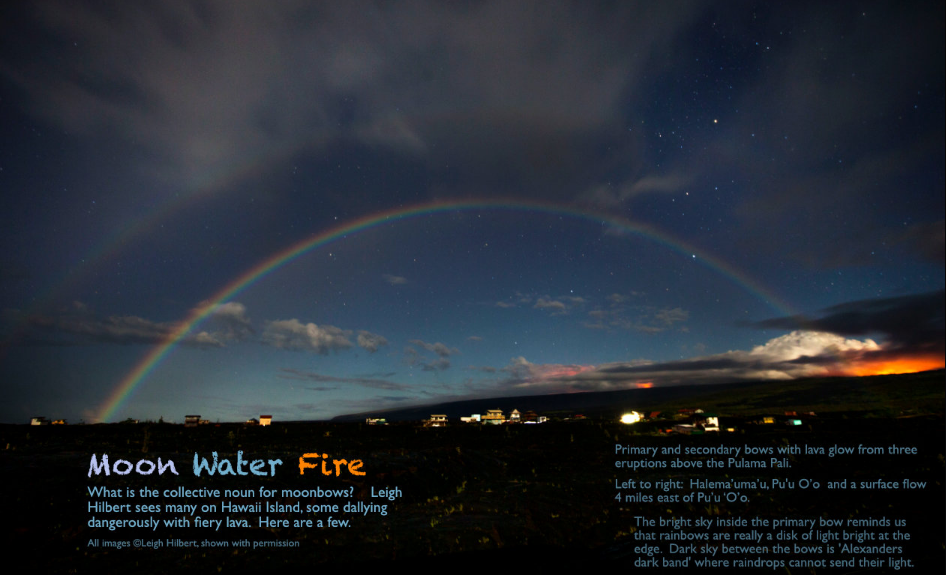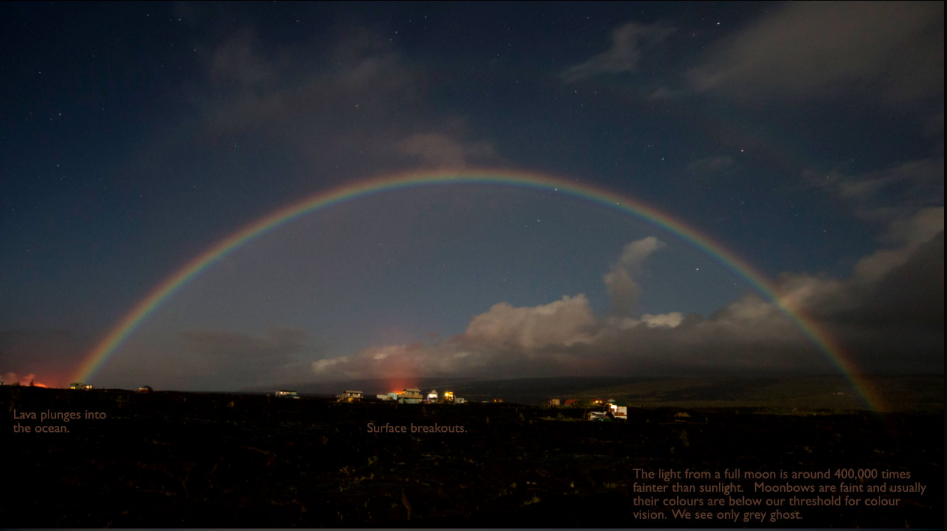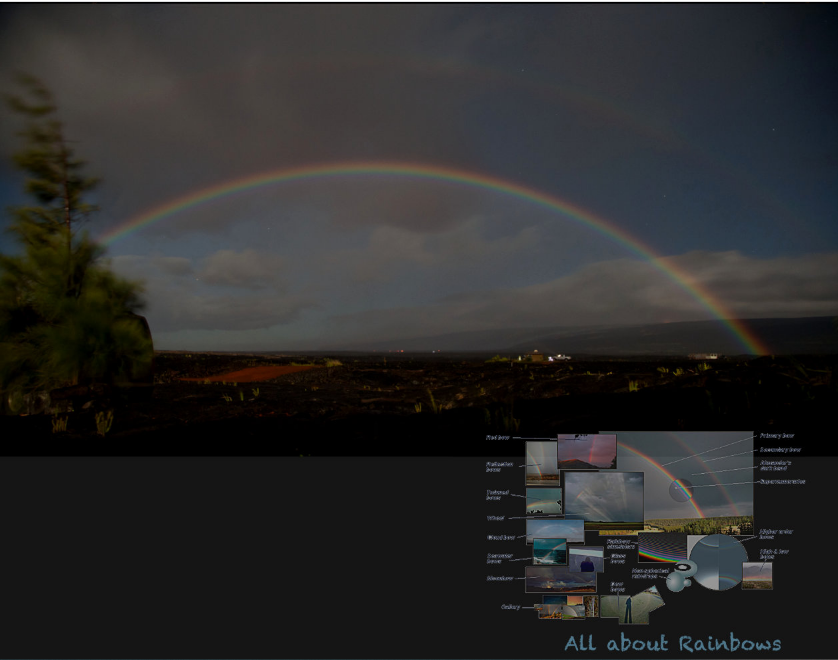Moonbows Hawaii
Moonbows in Hawaii: A Spectacular Natural Phenomenon
Moonbows, also known as lunar rainbows, are a breathtaking natural phenomenon that occurs when the light from the moon is refracted and reflected by water droplets in the atmosphere. While rainbow formations are commonly associated with sunlight, moonbows offer a rare and mesmerizing display of colors during the night. Hawaii, with its unique combination of volcanic activity, lush landscapes, and clear skies, provides the perfect backdrop for experiencing these ethereal lunar rainbows.
The Enchanting Dance of Moonbows and Lava Glow
One photographer, Leigh Hilbert, has had the extraordinary opportunity to witness and capture the magic of moonbows on Hawaii Island. These moonbows intertwine with the fiery glow of lava, creating a truly otherworldly spectacle. Hilbert's photographs showcase primary and secondary bows against the backdrop of lava eruptions above the Pulama Pali. The radiant sky inside the primary bow serves as a reminder that rainbows are actually disks of light, bright at their edges. The dark sky between the bows, known as "Alexanders dark band," is where raindrops cannot transmit their light, creating a striking contrast.
Moonbows and the Subtle Beauty of Grey Ghosts
Moonlight is significantly fainter than sunlight, measuring approximately 400,000 times less intense. Consequently, moonbows tend to be much dimmer and their colors often fall below our threshold for color vision. Instead of vibrant hues, we are greeted with a spectral palette of delicate shades, often appearing as ghostly greys. This subtlety only adds to the enchantment of moonbows, as they appear as elusive and ethereal spectacles in the night sky.
The Science Behind Moonbow Formation
To understand how moonbows form, we must delve into the science of atmospheric optics. Moonlight enters water droplets suspended in the air, causing the light to refract, or bend, as it passes from one medium to another. This bending of light is responsible for the separation of colors in the visible spectrum, creating the stunning arc of a moonbow. The primary bow is formed when the light refracts once inside the droplet and reflects off the inner surface before exiting. The secondary bow, less intense and fainter than the primary bow, is created by light refracting twice within the droplet.
Ideal Conditions for Moonbow Sightings
Several factors contribute to the optimal conditions for witnessing moonbows in Hawaii. Firstly, a nearly full moon provides the necessary illumination for moonbows to form. Additionally, clear skies are essential to ensure that the moonlight can reach the water droplets without obstruction. The presence of waterfalls or mist also enhances the chances of seeing a moonbow, as it increases the availability of water droplets in the air. Hawaii's diverse topography, with its cascading waterfalls and abundant rainfall, creates an environment where these conditions align more frequently.
Other Locations for Moonbow Sightings
While Hawaii offers a unique setting for moonbow sightings due to its volcanic activity and natural beauty, it is not the only place where these ethereal phenomena occur. Moonbows can be witnessed in various locations around the world under specific circumstances. Some notable spots include Victoria Falls in Zimbabwe and Zambia, Cumberland Falls in Kentucky, USA, and Iguazu Falls on the border of Argentina and Brazil.
Capturing the Magic: Tips for Photographing Moonbows
Photographing moonbows can be a challenging yet rewarding endeavor. Here are a few tips to help you capture the magic of these elusive phenomena:
- Use a tripod: Moonbows are often faint and require longer exposure times. A sturdy tripod will help stabilize your camera and minimize blurriness.
- Adjust your camera settings: Experiment with longer exposures, higher ISO settings, and wider apertures to capture the delicate details of the moonbow.
- Consider composition: Incorporate interesting foreground elements, such as waterfalls or unique landscapes, to add depth and context to your moonbow photographs.
- Be patient and plan ahead: Moonbows are not always visible, so plan your shoot around the lunar cycle and weather conditions. Patience is key when waiting for the perfect moment to capture this ephemeral beauty.
In conclusion, moonbows in Hawaii offer a captivating blend of natural wonders. The convergence of moonlight, water droplets, and volcanic landscapes creates an enchanting visual spectacle. While their colors may be subtle, moonbows leave an indelible impression on those fortunate enough to witness them. Whether you're an avid photographer or simply a lover of nature's marvels, experiencing a moonbow in Hawaii is a truly unforgettable experience. So, keep your eyes on the night sky and immerse yourself in the magic of these elusive lunar rainbows.

Moon Water Fire
What is the collective noun for moonbows? Leigh Hilbert sees many on Hawaii Island, some dallying dangerously with fiery lava. Here are a few.
All images ©Leigh Hilbert, shown with permission
Primary and secondary bows with lava glow from three eruptions above the Pulama Pali.
Left to right: Halema'uma'u, Pu'u O'o and a surface flow 4 miles east of Pu'u 'O'o.
The bright sky inside the primary bow reminds us that rainbows are really a disk of light bright at the edge. Dark sky between the bows is 'Alexanders dark band' where raindrops cannot send their light.

Lava plunges into the ocean.
Surface breakouts.
The light from a full moon is around 400,000 times fainter than sunlight. Moonbows are faint and usually their colours are below our threshold for colour vision. We see only grey ghost.

Note: this article has been automatically converted from the old site and may not appear as intended. You can find the original article here.
Reference Atmospheric Optics
If you use any of the definitions, information, or data presented on Atmospheric Optics, please copy the link or reference below to properly credit us as the reference source. Thank you!
-
<a href="https://atoptics.co.uk/blog/moonbows-hawaii/">Moonbows Hawaii </a>
-
"Moonbows Hawaii ". Atmospheric Optics. Accessed on November 25, 2024. https://atoptics.co.uk/blog/moonbows-hawaii/.
-
"Moonbows Hawaii ". Atmospheric Optics, https://atoptics.co.uk/blog/moonbows-hawaii/. Accessed 25 November, 2024
-
Moonbows Hawaii . Atmospheric Optics. Retrieved from https://atoptics.co.uk/blog/moonbows-hawaii/.